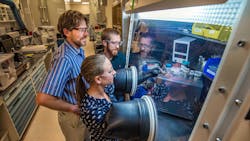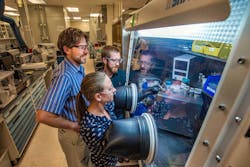A team of engineers at Sandia National Laboratories has modified and improved molten sodium batteries, with an eye toward grid-scale energy storage that could store power from renewable sources (wind and solar) to make them more viable.
The new battery operates at about 230°F, unlike current commercially molten sodium batteries (known as sodium-sulfur batteries) which typically operate between at 520° and 660°F. The lower temperature lets batteries be made of less-expensive materials, use less insulation, and contain thinner wiring, all of which lowers costs.
However, the battery chemistry that works at 550°F doesn’t work at 230°F, so the team had to come up with a new one. To do so, the team developed what it calls a catholyte, a liquid mixture of two salts—in this case, sodium iodide and gallium chloride.
Common lead-acid batteries use a lead plate and a lead dioxide plate separated by a sulfuric acid electrolyte. In the new molten sodium battery, the lead plate is replaced by liquid sodium metal and the lead dioxide plate is replaced by a liquid mixture of sodium iodide and a small amount of gallium chloride. Because both sides of the battery are liquid, there are no issues with materials undergoing complex phase changes. This gives them a longer life than conventional batteries.
To create electricity in the new battery, the sodium metal produces sodium ions and electrons. On the other side of a ceramic separator which only lets sodium ions move through it, sodium ions react with the iodide ions to form molten sodium iodide salt.
Sandia’s small, lab-scale sodium-iodide battery prototype was tested for eight months inside an oven where it was charged and discharged more than 400 times.
When the COVID-19 pandemic struck, the team had to pause the experiment for a month and let the molten sodium and the catholyte cool to room temperature and then freeze. When the team then warmed up the battery, it still worked. This means that if there were a power outage, sodium-iodide batteries could be tapped and allowed to cool until frozen. Once power is restored, the batteries could be warmed, recharged, and returned to normal operation without a lengthy or costly start-up process, and without degrading the battery’s internal chemistry.
Sodium-iodide batteries are also safer than other batteries. Lithium-ion batteries, for example, catch on fire if there is a failure inside of them, and this leads to runaway overheating. That cannot happen in the new molten sodium batteries. Were the ceramic separator to be removed, the sodium metal would mix with the salts, but there would be no fire or violent chemical reactions. Even if the new battery was engulfed in flame, the battery might crack and fail, but it shouldn’t add fuel to the fire or cause its own sodium fire.
Another advantage of the new battery chemistry is that it puts out 3.6 V, 40% more than commercial molten-sodium batteries. This means they have higher energy densities so battery packs would need fewer cells and fewer connections between cells, while having lower unit costs to store the same amount of electricity.
The next step for the team is to refine the catholyte chemistry and replace the gallium chloride. Gallium chloride is expensive—more than 100 times as expensive as table salt.
The team is also working on various engineering tweaks to get the battery to charge and discharge faster and more fully. One tactic is to speed charging by coating the molten sodium side of the ceramic separator with a thin layer of tin.
It would likely take five to 10 years to get sodium-iodide batteries to market, with most of the remaining challenges being commercialization challenges rather than technical ones, according to the team.

